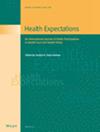The Feasibility and Relevance of Collecting Adolescent Health Indicators in Humanitarian Settings: Results From the West Bank
Abstract
Background
There is a critical concern for adolescent health in the Eastern Mediterranean region especially during humanitarian crises. This study emphasises not only the need for measuring key health indicators but also how to collect the information effectively, particularly in the West Bank. These efforts will guide evidence-based policies and interventions for this population.
Setting and Participants
This mixed-methods study aimed to determine the perceived relevance and feasibility of collecting a set of adolescent health indicators in the West Bank. Stakeholders filled out a questionnaire and participated in a workshop where they ranked 50 indicators based on context specificity, usefulness, feasibility, timeliness and resource availability. The researchers analysed the data and categorised the indicators as feasible and relevant, feasible but irrelevant, not feasible but relevant, or not feasible and irrelevant.
Results
The results of the study show that 22 out of the 50 adolescent health indicators were perceived as both feasible and relevant to be collected in the West Bank. These indicators cover a range of content areas, including determinants of health, mortality, morbidity, health behaviour and risks, policies, systems, interventions, and mental health and well-being. However, some indicators were deemed relevant but not feasible due to cultural norms, stigma and wording issues, while others were considered not relevant and not feasible, including certain indicators related to alcohol use and unavailable practices and services. Despite the challenges, stakeholders acknowledged the importance of creating a national list of adolescent health indicators to guide evidence-based programmes and policies, emphasising the need for governmental support and infrastructure for data collection.
Conclusion
Cultural norms, stigma and wording issues emerged as significant challenges in data collection. Recommendations include implementing comprehensive sexual education, improving mental health indicator wording and investing in resources to support data collection and measurement. These findings will help guide evidence-based programmes and policies for adolescent health in the region. The establishment of a national list of adolescent health indicators services is a milestone for standardising data collection, guiding health programme planning and fostering accountability. Overall, this study's findings will significantly improve understanding, interventions and prioritisation of adolescent health in the region, potentially influencing similar contexts worldwide.
Patient or Public Contribution
Our study could not have been done without the involvement of service providers. Major adolescent service providers were provided with a list of indicators and asked to rank their feasibility and relevance. The results of their rankings were then shared in a workshop. A presentation was given on the ranking of the stakeholders, and they were given a chance to discuss any agreements or concerns with the tentative list of indicators.

 求助内容:
求助内容: 应助结果提醒方式:
应助结果提醒方式:


